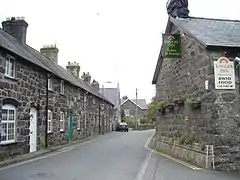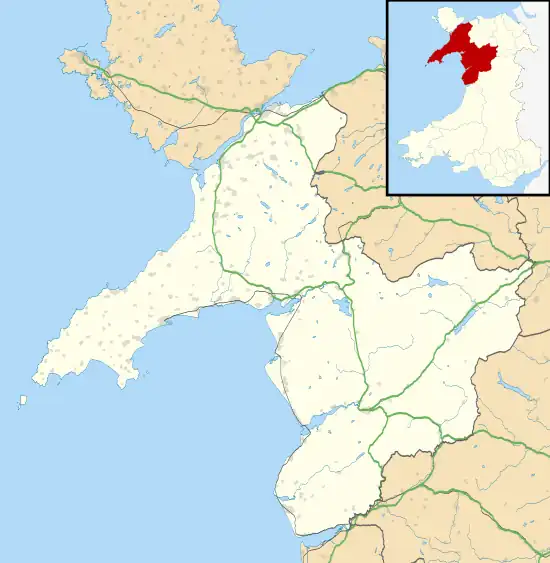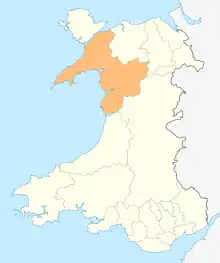| Llanuwchllyn | |
|---|---|
 Main street in 2007 | |
 Llanuwchllyn Location within Gwynedd | |
| Area | 116.93 km2 (45.15 sq mi) |
| Population | 617 (2011) |
| • Density | 5/km2 (13/sq mi) |
| OS grid reference | SH877299 |
| Community |
|
| Principal area | |
| Country | Wales |
| Sovereign state | United Kingdom |
| Post town | BALA |
| Postcode district | LL23 |
| Dialling code | 01678 |
| Police | North Wales |
| Fire | North Wales |
| Ambulance | Welsh |
| UK Parliament | |
| Senedd Cymru – Welsh Parliament | |


Llanuwchllyn (Welsh: [ɬaˈnɨ̞u̯χɬɨn] ⓘ) is a village and community in Gwynedd, Wales, near the southern end of Bala Lake (Llyn Tegid). It is one of the most sparsely populated communities in Wales.
The electoral ward includes the small settlement of Llangywer.
The parish church of St Deiniol is a Grade II* listed building.[1]
Llanuwchllyn railway station is the headquarters of the narrow gauge Bala Lake Railway, centred on the former Great Western Railway station on the standard-gauge line from Ruabon to Barmouth.
The village was the birthplace of Welsh language author and educationalist Owen Morgan Edwards.
Caer Gai, a Roman fort near Llanuwchllyn, was traditionally known as the home of Cei, the character in the Arthurian legend known in English as Sir Kay. Poets of the 15th century recorded a story, ultimately deriving from the Prose Merlin included in the Lancelot-Grail and the Post-Vulgate Cycle, that King Arthur and Cei were brought up at Caer Gai as foster brothers.[2] Caer Gai is also Grade II* listed.[3]
Demographics
Welsh language
According to the 2011 Census, Llanuwchllyn is the community with the 2nd highest percentage of Welsh speakers in Wales. 83.5% of residents aged three and over reported being able to speak Welsh in the 2011 Census, as compared to 84.7% reporting being able to do so in the 2001 Census.[4] The figure rose slightly to 83.9% by the 2021 Census. [5]
Ethnicity
As of the 2021 Census, the Llanuwchllyn electoral ward was the least ethnically diverse ward in England and Wales. 99.2% of residents were White British, 0.2% were White Irish, 0.3% were White Other, and 0.3% were mixed race.[6]
Governance
An electoral ward with same name exists. This ward also includes the community of Llangywer with a total population taken at the 2011 census of 877.[7]
Notable people
- John Richards (1765–1850), schoolmaster, became an American politician in New York.
- Michael D. Jones (1822–1898) a Welsh Congregationalist minister, principal of a theological college and co-founder of the Welsh settlement of Y Wladfa in Patagonia.
- Sir Owen Morgan Edwards (1858–1920) historian, educationalist and writer.
- John Meirion Morris (1936–2020), sculptor.[8]
Notes
- ↑ "Parish Church of St Deiniol, Llanuwchllyn". British Listed Buildings. Retrieved 17 December 2013.
- ↑ Bromwich, p. 311.
- ↑ "Caer Gai, including adjoining forecourt walls to the NE, Llanuwchllyn". British Listed Buildings. Retrieved 17 December 2013.
- ↑ "Comisiynydd y Gymraeg - 2011 Census results by Community". www.comisiynyddygymraeg.cymru. Retrieved 4 September 2020.
- ↑ "Welsh language skills (speaking) - Office for National Statistics". www.ons.gov.uk. Retrieved 11 March 2023.
- ↑ "Ethnic group - Office for National Statistics". www.ons.gov.uk. Retrieved 11 March 2023.
- ↑ "Ward population 2011". Retrieved 17 May 2015.
- ↑ "Tryweryn monument sculptor John Meirion Morris dies age 84". Nation Cymru. 21 September 2020.
References
- Bromwich, Rachel (2006). Trioedd Ynys Prydein: The Triads of the Island of Britain. University Of Wales Press. ISBN 0-7083-1386-8.
